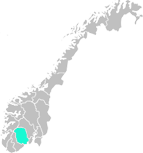



km
8 kmThe Saboteur trail goes in varied terrain, mostly forest, at 450-1040 metres above sea level.
The saboteur's trail is the path the world-famous Norwegian resistance used during the World War 2, the night they ought to blow up the heavy water plant at Vemork.
The tour starts from Rjukan Fjellstue. From Rjukan Fjellstue you follow the gravel road for a little while, then it turns east, through varied forest - and mountain terrain.
Along the way there are information boards that tell you the history when Norwegian saboteurs went from Hardangervidda, and down the steep gorges to Rjukan to blow up the heavy water plant.
The spectacular nature makes the trip even more special. The trail is well marked, with some steep descent towards the end. During the trip you will have impressive views of Rjukan and the Norwegian Industrial Workers' Museum
Good footwear is essential. On rainy days boots are recommended as the trail can be wet and somewhat muddy.
Suitable for: Normally fit persons
Distance: About 8 kilometres
Time: About two hours
Starting point: Rjukan Fjellstue, 11 km west from Rjukan
Parking: Rjukan Fjellstue or Vemork (bus to Rjukan Fjellstue at 13.10 from Våer/Vemork, check vy.no for always updatet bus)
Directions to starting point: From Rjukan town centre, drive towards Rauland in the west. After approximately 11 kilometres follow signs to Rjukan Fjellstue.
Buy map at: Rjukan Tourist Office, Torget 2, phone: +47 350 80 550
Guided tours
There are choices of guided tours in the saboteur's footsteps. The guided tours are upon request, send an e-mail to us on info@visitrjukan.com.
Package
Get a close encounter with Rjukan's exciting war history with our package "In the saboteur's footsteps".
Read more about the package at http://www.visitrjukan.com/en/best-travel-tips
Be a sustainable hiker
When exploring nature, it's essential to practice responsible behavior to preserve and respect the natural environment. This includes staying on the marked trails to avoid damaging ecosystems, taking your litter with you, and respecting local rules and restrictions. Make sure to avoid disturbing wildlife and be mindful of any special considerations related to protected areas. By acting responsibly during your outdoor activities, you contribute to maintaining the beauty and sustainability of nature, ensuring future generations to be able to enjoy it as well.
At the Norwegian Industrial Workers Museum at Vemork you can see the unique exhibition…
The sun mirrors bring sun down to Rjukan Square during winter months, when it is normally…
The mountain Gaustatoppen in Rjukan in Telemark county is easily accessable and one of…
Vieving stones.
Eight different sculptured "vieving stones" have been placed in to the…
The museum shows sculptures, paintings, graphic art and drawings by the famous artist…
The Skinnarland Collection houses more than 100 works of art by sculptor Knut Skinnarland…
Raulandsakademiet is a course center, a hostel and a rural museum.
A collection of replicas of local traditional log buildings, filled with cultural…
Gallery Nutheim was opened in 1978. The Gallery exhibits art by local artists. Nutheim…
Vieving stones.
Eight different sculptured "vieving stones" have been placed in to the…
Vieving stones.
Eight different sculptured "vieving stones" have been placed in to the…
Vieving stones.
Eight different sculptured "vieving stones" have been placed in to the…
Vieving stones.
Eight different sculptured "vieving stones" have been placed in to the…
The history of Sondre Norheim begins in Morgedal, Telemark.